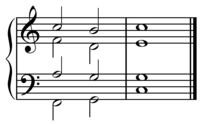I–IV–V–I


In music, I–IV–V–I or IV-V-I is a common chord progression and cadence that, "unequivocally defines the point of origin and the total system, the key."[1]
Composers often begin pieces with this progression as an exposition of the tonality:[1]


It may be viewed as an abbreviated circle progression:
I-IV- V-I = I–IV–V–I

"Along with motion toward the fifth (V), IV [the subdominant] appears as a corrective, depriving V (the dominant) of its independence and pointing it back in the direction of its origin [I]."[1] In the key of C, IV provides the note F♮ and eliminates the possibility of G major, which requires F♯.[1] The progression is also often used at the end of works and sections.[1]
